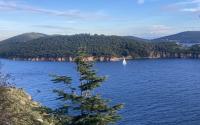16 May 2007Catherine Brahic
Vast areas of snow in Antarctica melted in 2005, when temperatures warmed up for a week in the summer. Snow melts such as this may have ramifications for larger scale melting of the ice sheets if they are severe or sustained over time, NASA said on Tuesday.
A new analysis of satellite data showed that an area the size of California melted and then re-froze – the most significant thawing in 30 years, the US space agency said.
Duncan Wingham at University College London in the UK says the event is "notable". But he underlines that it is, for now, a single weather event and should not be confused with long-term climate change.
"If we were to start seeing this happen every single year, then we would have to say: 'Yes this [Antarctica] is not the sort of deep freeze we have been thinking'," he told New Scientist.
Unlike the Arctic, Antarctica has shown little to no warming in the recent past with the exception of the Antarctic Peninsula, where ice sheets have been breaking apart.
And although studies have shown that Antarctica is shrinking, researchers say this is not because the continent is melting. Rather, they say its glaciers are flowing into the ocean faster than they are being replenished by snow. (See What's behind the big polar meltdown?.)
NASA says the continent melted in multiple areas in 2005, including far inland, at high latitudes and high elevations, where such melting had previously been considered unlikely.
A team led by Son Nghiem of NASA's Jet Propulsion Laboratory in Pasadena, California, and Konrad Steffen of the University of Colorado in Boulder, used satellite scatterometry – a sophisticated imaging system which is able to distinguish between recently frozen ice or snow from snow that has been frozen for years.
Sea level rise
The researchers measured snowfall accumulation and melt in Antarctica from July 1999 through July 2005.
They found evidence of melting in several areas in January 2005, when temperatures got as high as 5°C (41°F). The melt was intense enough to create an extensive ice layer when water refroze after the melt, they say. Such "ice lenses", where ice has melted and re-formed, have been seen in Antarctica before but not so far into the centre of the continent. "Clearly there has been a warm event," says Wingham.
However, the melt was not prolonged enough for the melt water to flow into the sea.
"Increases in snowmelt, such as this in 2005, could definitely have an impact on larger scale melting of Antarctica's ice sheets if they were severe or sustained over time," Steffen says. "Water from melted snow can penetrate into ice sheets through cracks and narrow, tubular glacial shafts called moulins."
If sufficient melt water is available, it may reach the bottom of the ice sheet. This water can lubricate the underside of the ice sheet at the bedrock, causing the ice mass to move toward the ocean faster, increasing sea level, he explains. (See Greenland's ice velocity linked to lake creation.)






